Beverly Gray's Blog: Beverly in Movieland, page 15
May 10, 2024
Remembering the Wives: Eleanor Coppola and Samantha Davis

In Hollywood, as in the restof life, wives sometimes get overlooked. But two recent deaths have reminded meof how complicated (though rewarding) it can be to unite in marriage with amajor showbiz figure. Eleanor Neil met Francis Ford Coppola in Ireland, wherehe was shooting his first professional film, a Roger Corman cheapie called, Dementia13. (She was serving as assistant art director on the project. It cameabout because Corman had shot The Young Racers in the Emerald Isle, andfigured that cast and crew could quickly crank out one more film before theyall went home. ) The Coppolas wed in 1963, produced three children, and stayedmarried for the rest of their lives, despite a good deal of turbulence, as hemoved from the glory years of the Godfather films into more complicatedterritory. In 1976 Eleanor was present in the Philippines, with very young kidsin tow, as Coppola shot his Vietnam epic, Apocalypse Now (released in1979). The chaos of that experience (including Martin Sheen’s nervousbreakdown and a typhoon that destroyed an expensive set) was captured in herdiaries, which she shaped into a pull-no-punches 1979 book, The Making ofApocalypse Now. It’s been years since I read it, but I recommend it as afascinating behind-the-scenes look at the emotional toll that’s taken when amovie crew moves to a distant land to shoot a difficult film.
So warmly was EleanorCoppola’s book received that she helped turn it into a documentary film, whichshe co-directed with Fax Bahr and my old friend George Hickenlooper. Heartsof Darkness: A Filmmaker’s Apocalypse appeared in 1991, and quickly pickedup awards, including an Emmy for "Outstanding Individual Achievement –Informational Programming – Directing.” Thereafter, Eleanor tried her hand atfeature filmmaking, directing the 2016 romantic comedy, Paris Can Wait aswell as 2020’s Love is Love is Love. She also published a second book, Noteson a Life, which chronicled the doings of her famous family, including thedeath of her first-born son Gian-Carlo at the age of 22 and her husband’smuch-maligned decision to cast daughter Sofia in a key role in TheGodfather, Part III. Nor did Eleanor give up documentary filmmaking,chronicling the making of Sofia’s 2006 feature, Marie Antoinette.
Eleanor passed away on April12 of this year, at the age of 87 in Rutherford, California, seat of thefamily’s well-known winery There’s little question that hers was a remarkablyproductive life.
Far less well-known wasSamantha Davis, who died on March 24 at the age of 53. She was the longtimewife of Warwick Davis, who starred in George Lucas and Ron Howard’s Willow.. In this 1988 fantasyfilm, the still-teenaged Davis (all of three foot six inches tall) played ahero who saves a kingdom from evil usurpers. Part of the drama takes place inthe village of the Nelwyns (supposedly a race of tiny people all under four feettall). For these scenes, little people were recruited from around the globe,and they joyously bonded with one another, leading director Howard to say, “Tosee them interacting, performing, working hard, laughing, playing, carrying on. . . that was to me I think maybe the greatest experience in the movie.”
On set Warwick first got toknow Samantha, and they married soon thereafter. Though in Willow shewas simply a villager, she did rack up several other acting credits, includinga role in one of the Harry Potter films. Together they founded a charitableorganization, Little People U.K. Histributes to her memory are deeply moving.
May 7, 2024
Drifting through the UCLAx Film Festival

My home campus, UCLA, hasrecently made headlines with stories about protest encampments, pitchedstudent-on-student battles, and arrests, all pertaining to the tangledconflicts in the Middle East. But last Saturday I attended an event that waspeaceful and even joyous. For almost 30 years I’ve been an instructor throughUCLA Extension, which welcomes students from all over the world who are keen toimprove their skills in a variety of disciplines. Last week Extension hostedUCLAx Film Festival 2024, a gathering of up-and-coming filmmakers who’ve takenpertinent courses in its entertainment studies division or the writers’ programin which I teach. I consider this festival a well-kept secret that should bebetter known. I attended this year, for the very first time, because one of myscreenwriting students alerted me that his short film would be among thosefeatured.
The festival, I’vediscovered, is eight years old. Naturally, during the pandemic, it was onlineonly. And this year’s event was postponed from fall 2023 to spring 2024 becauseof the long-lasting Writers Guild strike. Still, the event I just attended wasa total wow! Introductory days of festivities and panels were followedby the main event, held this year in Downtown L.A.’s fabulous Los AngelesTheatre, a French baroque-style movie palace where in 1931 Charlie Chaplin oncepremiered City Lights. The Downtown location, which was mercifully farfrom the campus disturbances of the past week, served to highlight UCLAExtension’s commitment to offering educational opportunities in L.A.’s businesshub. And the swanky afterparty (free to all attendees) was a delight.
So how were the films? Theseprofessional-quality gems, all 15 minutes or under, represented a wide varietyof styles, themes, and even nationalities. (There were subtitled films shot inSpanish, French, Turkish, and Farsi) Among the 19 entries were piquant studies of lost souls; a documentarysaluting a ninety-year-old woman whotakes a very personal approach to feeding the hungry, a musical tale of a bearinvading an L.A. neighborhood, and a love story involving a malfunctioningandroid. The five prizes awarded at the end of the day showcased the range andquality of the work on display. The audience prize went to The Dot, awhimsical story of a lonely man in an art gallery. Another honoree was Elevate,about a taut late-night encounter between a security guard and a tenant in thehigh-rise where she works. Andean Condor, gorgeously shot inSouth America, was a prize-winner too, as was the uproariously goofy The1971 Kitchen Grand Brie, which used computer-aided animation to bring us the world’s tastiest road race, inwhich racing star Armando Fettuccini finally gets his just desserts.
I’ve saved the best for last.My former student, Christopher Hills Eaton, was the writer/director/producer ofan animated film that condenses the story of a full life into 9 ½ poignantminutes. I had absolutely nothing to do with Driftwood, but I haveread enough of Chris’s past work (andlearned enough about his family story) to know him as a man of sensitivity anddeep emotions. Driftwood begins with a young sailor knocked into the seain the chaos surrounding Pear Harbor. His salvation comes as he clings to alarge chunk of driftwood, and the eccentrically-shaped log follows him through the restof his life. When the lights came up, my husband asked me if I had a Kleenex Icould spare. This was my first discovery that I wasn’t the only one watchingthe end of the film through tears. Bravo,Chris!
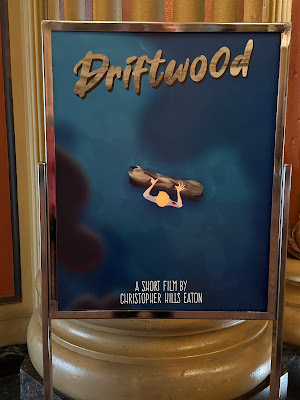
For more information aboutthe festival and this year’s films, see https://www.uclaextension.edu/uclaxfilmfest
May 3, 2024
Marilyn Chambers: 99 & 44/100% Pure
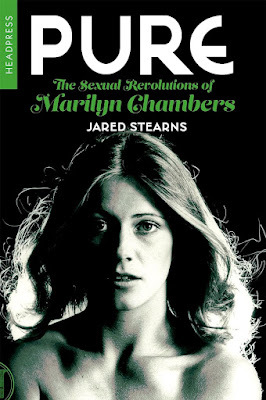
In 1997 a Paul ThomasAnderson film called Boogie Nights captured three Oscar nominations anda number of lesser prizes. This colorful look at the rise of a well-endowedyoung man renewed movie-goers’ fascination with the Golden Age of Porn(basically 1969-1974). The adult film industry had first gained wide popularitywith the release of 1972’s Deep Throat, an x-rated flick that lives onas a reference to a certain Watergate-era snitch. Once it became chic for thegeneral public to seek titillation at venues like the Pussycat Theater, LindaLovelace (displaying her unusual talents in Deep Throat) and GeorginaSpelvin (on display in The Devil in Miss Jones) attracted international attention.But the most complex and compelling of adult movie stars seems to have beenMarilyn Chambers, an All-American blonde who burst into the publicconsciousness as the leading lady in the Mitchell Brothers’ Behind the GreenDoor (1972).
Chambers, barely 20, waspretty, athletic, and enthusiastic about sex in all its forms. She had also, asit turns out, just been prominently featured on the box of Procter &Gamble’s new laundry detergent, Ivory Snow, as a loving young mother cuddling ahappy baby. The longtime slogan for Ivory products? “It’s "99 &44/100% pure.” The contrast between Chambers’ innocent looks and her scandalousreputation boosted her notoriety, and gave my colleague Jared Stearns a niftytitle for his brand-new Chambers biography, Pure.
Jared, a fellow member ofBiographers International Organization, has been fascinated by the life ofChambers (born Marilyn Briggs, and comfortably raised in tony Westport,Connecticut) for decades. In the course of his research, he’s connected withvirtually everyone still living who’s played a part in Chambers’ eventful life,including her siblings, her daughter, and her closest friend. Jared isparticularly good at pointing up Chambers’ many self-contradictions. Though shewas bold and sassy in public appearances as well as on the talk-show circuit,she was easily dominated by most of the men in her life, including her longtimehusband and manager, Chuck Traynor. (He was a shrewd but volatile man, who hadpreviously been married to, and guided the emergence of, Linda Lovelace. Jaredhardly minces words in describing him: “an illiterate, abusive, opportunisticmisogynist.”) Chambers also had asurprising domestic streak, but underwent at least one abortion due toTraynor’s insistence. It was not until she moved on to a (somewhat) more stableman that she finally had the child she’d hoped for, and became a loving parent.
In tracing Chambers’ career,Jared reveals how difficult it was for her to convert her fame into the seriousacting opportunities she craved. Spurned over and over by mainstream Hollywood,she starred in a nightclub act and launched a one-woman drama called “SexSurrogate” that was banned from Las Vegas (!) because it contained full frontalnudity. But though Jared focuses in on Marilyn’s life, he doesn’t ignore whatwas happening in the world around her. The mid-1980s was the era when thescourge of AIDS was rocking the adult film industry, one more way in whichMarilyn’s livelihood was facing jeopardy.
In a fascinating digression,Jared explains how his subject’s combination of bold sexuality and personalelegance made her a magnet for gay men, to the point where “it’s a wonder whyMarilyn Chambers isn’t as prominently revered in the gay community as Madonna,Mae West, or Mamie Van Doren. Shehas many hallmarks associated with diva worship.”
By the way, Marilyn Chambersdidn’t care for Boogie Nights’ depiction of the world she knew so well. To her it was simply “inaccurate.”
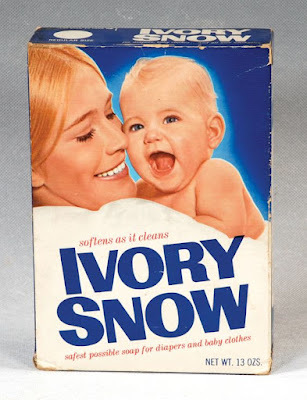
April 30, 2024
A Heartfelt Ode to Lovers and Other Strangers
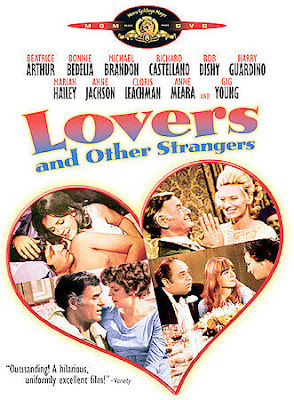
Yes, I’m a bit of a suckerfor wedding movies, especially those that suggest that it’s possible to achievewedded bliss. Lovers and Other Strangers came out in 1970, when I washeading toward marriage myself. I’m not sure this little film acknowledges thepossibility of happily ever after, but it’s both romantic (at times) andextremely funny (often).
Two of the writers of thisfilm are Renée Taylor and Joseph Bologna, a married couple who presumably knewthe territory. They first launched this comedy on Broadway, where it was a hitof the 1968 season, with Taylor in a key role. She doesn’t appear in the film,which was co-written by David Zelag Goodman, but the three shared an Oscarnomination for their screenplay. (By the way, Bologna passed on in 2017, butTaylor is still around at the ripe old age of 91.)
The centerpiece of the filmis the wedding of two attractive young New Yorkers, Susan (Bonnie Bedelia) andMike (Michael Brandon). Though their parents don’t know it, they’ve beensharing an apartment for a year. Now, on the eve of their wedding, Mike isn’tsure he wants to change the status quo. But Susan, who seems to have goodinsight into the working of her boyfriend’s mind, cheerfully proceeds with thegown fitting and other plans for the elaborate out-of-town nuptials to whichthey’ve committed. In the course of their pre-wedding errands, we come to knowtheir families. Mike’s lower-middle-class Italian parents (Beatrice Arthur andthe Oscar-nominated Richard Castellano) seem in many ways to be a mismatch:she’s devoutly Roman Catholic and he has had a few extramarital flings, butdoesn’t see the point in going to confession. Yet though they bicker constantlyand don’t pretend to be entirely happy with one another, they’re unified intheir horror that older son Richie is on the brink of divorce. (Hhis prettyyoung wife is Diane Keaton, in her first film role. She’s a romantic wholaments that since a year or two of marriage, Richie’s hair no longer smellslike raisins.)
Meanwhile Susan’s affluentIrish-Catholic parents (Gig Young and Cloris Leachman) present themselves as anattractive married couple. This is a façade, however, because the very smoothHal is juggling his marital commitments and a fling with the woebegone Kathy(Anne Jackson). Kathy, alas, always seems to be weeping in the bathroom as Halweasels out of promises to divorce his wife. And there’s one more screwballcoupling, between a hot-to-trot cousin (Bob Dishy) and a ditzy bridesmaid(Marian Hailey) who’s really into Camus and Khalil Gibran. (When she mentionstaking part in the recent student protests on the campus of ColumbiaUniversity, he’s impressed that she’s an Ivy Leaguer. No, she earnestlyexplains, she was one of the “outside agitators” there.)
With all this going on, it’sremarkable that the wedding comes off as planned, leaving us hoping that atleast one couple will find joy in holy matrimony, at least for now. The filmwon favor both from audiences and Oscar voters, earning three nominations. (Itsonly victory was for its song, “For All We Know,” which became a hit for TheCarpenters and a staple at weddings from that day to this.)
An eerie postscript: GigYoung, the one-time Oscar-winner who plays the straying father of the bride,was married five times. His last marriage, in 1978 when he was 64, was to a31-year-old German magazine editor. Three weeks later, he apparently killed hiswife and then himself. So much for happily ever after.
.
April 26, 2024
Linking Up on the Links: “Tin Cup”
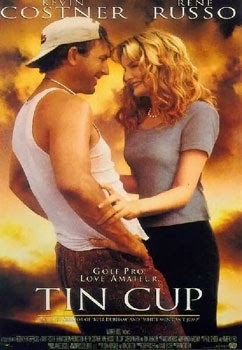
When it comes to golf, Idon’t know a birdie from a bogey. So a movie that’s all about golf should not speakto me. Still, I was a big fan of Ron Shelton’s baseball-related directorialdebut, Bull Durham (1988). Four years later, Shelton made playgroundbasketball sexy in White Men Can’t Jump. So I was curious to see what hecould do on the golf links, especially since Tin Cup (1996) reunited himwith the star of Bull Durham, Kevin Costner.
I’m not always a KevinCostner enthusiast, especially in films that require him to be solemn andheroic. (See, for instance, Dances with Wolves.) In Tin Cup he’squite the opposite: something of a grifter who just happens to have remarkablegolf skills, but is too much in love with crazy bets and show-offy gambles tomake a real career out of a sport he loves. Shelton describes his Roy “Tin Cup”McAvoy as a archetypal American hustler-conman-loser who has a gift forself-destruction. To my surprise, he reminded me a great deal of Jimmy McGill,Bob Odenkirk’s talented but sleazy lawyer in the TV series, Better CallSaul. (The two men even have a similar look: clean-cut but diabolical.) Thefilm ends up with Roy in a position to win—to everyone’s astonishment—the U.S.Open, but the outcome is not what you might expect.
Following some success on hiscollege golf team, Roy has made a life for himself running a driving-range inan out-of-the-way desert spot called Salome, Texas, where the greens are hardlygreen, and armadillos are an occasional hazard on the course. (The movie openswith a series of colorful roadside signs including this one: “Last chance tohit golf balls fore 520 miles.”) Not much concerned about money, Roy hangs outwith a scruffy group of golf buddies, drinking beers, making creative wagers,and giving the occasional golf lesson to a newbie. Such a one is Dr. MollyGriswold (Rene Russo), a feisty and attractive clinical psychologist who showsup with hundreds of dollars’ worth of questionable golf gear. She’s datingRoy’s college nemesis, David Simms (Don Johnson), now a star professionalgolfer who holds charity tournaments and never misses a chance to needle Royabout his less than stellar accomplishments on the links. Naturally, Roy andMolly can’t fight their growing attraction, especially when she discovers (natch!)that big-hearted, charitable David is really a jerk behind the scenes.
Though I delighted in Roy’sdevil-may-care personality, Dr. Molly didn’t work for me. Yes, she has colorfulmoments, but the character seems less a reflection of true human behavior thana construct by a screenwriter looking to find an original take on his leadinglady. Her backstory is a jumble ofromance with an Amarillo cowboy, years selling real estate, and suddenly anewly-minted psychotherapy degree. Frankly, it just doesn’t wash, though theromantic capitulation, when it comes, is jolly good fun, even while it leavesRoy’s caddy/guru/best friend out in the rain for a very long time.
Thatbest friend is played by Cheech Marin, best known for his drug-friendly comedyroutines with partner Tommy Chong. His role as Romeo Posar gives him theopportunity to be wise, to be funny, even to sing and to dance in sexy stylewith Roy’s ex-girlfriend, a bodacious stripper. I would be remiss in notmentioning Cheech’s off-screen passion for collecting Chicano art. He boaststhe largest such collection in the world, and in 2022 joined with the city ofRiverside, California to open The Cheech Marin Center for Chicano Art, Culture& Industry.
April 22, 2024
The 20th Century Fox of the Future
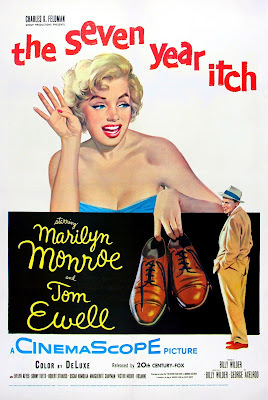
Growing up in a pleasantcorner of L.A. called Beverlywood (no, I had nothing to do with that), I wasquietly thrilled by the proximity of a famous movie studio. Yes, 20thCentury Fox was about a mile from my home. It was exciting to drive west onPico Boulevard and see the gates through which celebrities entered, along withhuge posters for such coming attractions as Cleopatra, The Sound of Music, andStar Wars. In later years, myhusband- to-be, along with members of my family, took part in the mammothparade down a fake New York street that was intended to be the high point of1969’s Hello, Dolly!
Of course, time marches on.Starting in 1963, much of Fox’s rambling backlot was sold to developers,resulting in the building of hotels, condo towers, and a high-end shopping mallknown collectively as Century City. (Such brand-new boulevards as Avenue of theStars played into the movie-star motif.) Then, after a series of ownership changes, most of the studio (includingits intellectual property) was purchased by Disney in 2019. Today the complexis known as 20th Century Studios: it houses Fox productions, makerof The Simpsons as well as other television favorites, and is also usedas rental space for additional TV and movie projects.
Unlike such storied Hollywoodproperties as Universal Studios, Fox has never been known for public outreach.Touring the lot is generally not an option, unless you have specific businesson the premises. But today that’s starting to change. A project called Fox Future is being organized to preserve andenhance the remains of one of Hollywood’s oldest studios, and the first tocommit itself wholly to the production of sound films. Among the plans: theresurrection of the Fox Research Library, which—like most of the old studiolibraries—had been shamefully allowed to disperse over the decades.
In tandem with Fox Future,the heroic L.A. Conservancy devoted itself on a rain-splashed recent Sunday(yes, it does rain in SoCal) toeducational tours of the lot. We glimpsed the commissary once visited by Sovietpremier Nikita Khrushchev (who there learned with dismay that his planned visitto Disneyland had been cancelled out of security concerns)), and were allowedinside a famous scoring stage. We gawked at giant murals commemorating thestudio’s greatest hits, like Gene Wilder and Teri Garr romping through YoungFrankenstein as well as Marilyn Monroe flirting with Tom Ewell in TheSeven Year Itch. Perhaps most charming were the earliest buildings on thelot, from the days when Hollywood studios pampered their über-famous contractplayers with private cottages tailored to their individual tastes. Stillstanding in the so-called Artist’s and Writer’s Village are several cozy butelaborately outfitted bungalows now used as office space but once dedicated tosome of the studio’s brightest stars. Will Rogers’s once-upon-a-time bungalowstill has its American Southwest flair. Next door is what originally was meant to look like awee Irish cottage. It was apparently built for the popular Irish tenor, JohnMcCormack, who made several films in the early 1930s. Eventually, it became the
home-away-from-home of one ofFox’s biggest Depression-era stars, Shirley Temple. Here’s one of my veryfavorite factoids from a tour docent: little Shirley was such a worldwidefavorite that she frequently received gifts from overseas fans. One admirer inAustralia sent a brace of live kangaroos. Soon they were hopping all over thelot, but ended up being corralled in an historic lily pond near the studio’soriginal main building. (You can’t make this stuff up!)
April 19, 2024
Saluting “An Officer and a Gentleman”
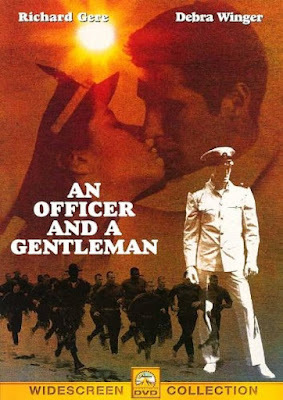
The recent passing of actorLouis Gossett Jr. at the ripe old age of 87 reminded me, of course, of hisgreatest screen triumph, in 1982’s An Officer and a Gentleman. For hisportrayal of a tough drill sergeant whose brutal methods mask a tender heart,Gossett became the first African-American ever to win an Oscar as BestSupporting Actor. It was a groundbreaking moment: the role had been written fora white man, but the production team had come to recognize that Black drillsergeants were not uncommon in the post-Vietnam military services. And Gossettgives it all he’s got.
Gossett is a marvel in thefilm, but so is the rest of the cast, led by Richard Gere, Deborah Winger, andDavid Keith. What struck me in rewatching it recently is how well it fits thedictum of screenwriting guru Paul Lucey, who advises newbies to “writesimple stories with complex characters.” Like the Top Gun films, AnOfficer and a Gentleman is all about would-be flyboys, going through atough round of training to prepare to pilot combat jets. But whereas Top Gun,starring action hero Tom Cruise, relies heavily on aerial stunt sequences, AnOfficer and a Gentleman sticks close to the ground. The main thrust of itsstory involves a thirteen-week training session at which hopefuls (includingone plucky woman) go through a series of exhausting physical and mentalexercises designed to scare off those unfit to achieve their dreams of flight.
Zack Mayo (leading manRichard Gere) is a particularly hard case. A loner who’s pretty much mad at theworld, he has survived his mother’s suicide and his father’s sordid lifestyleas a drunken and womanizing naval petty officer stationed mostly in the Philippines.Having made the surprising decision to enter Officer Candidate School, Zack isdetermined to leave the program with no strings attached. Which is why GunnerySergeant Foley’s warning to avoid getting serious with the marriage-hungrylocal factory girls makes perfect sense to him. But somehow he makes a friend(David Keith) who is quickly smitten by a buxom blonde ready to play any trickin order to land herself a pilot. And Zack himself is soon making sweet musicwith her best friend, the feisty Paula (an Oscar-nominated Debra Winger).
As week follows week, theOfficer Candidates face more and more pressure, both in their training sessionsand in the bedroom. (Director Taylor Hackford, who’d responded particularly tothe script’s blue-collar landscape and to its complex characterizations, wasfrank enough with the script’s enthusiastic sex scenes that the film wasoriginally given an X-rating.) At midpoint Zack, having tried the patience ofSgt. Foley once too often, is hounded into volunteering to quit the program.His stubborn determination—and the final, deeply emotional, acknowledgment thathe has nowhere else to go—keep him from leaving of his own accord. Later,though, once he’s faced the dire consequences of a pal’s bad choices, he’sready to leave the Navy behind. That’s when Sgt. Foley steps in again, leadingto a fiercely dramatic confrontation that helps Zack put his life intoperspective.
Those who’ve seen An Officer and aGentleman back in the mists of time will probably remember best its deeplyromantic ending, when Zack (resplendent in his white dress uniform) carries offthe loving Paula from her place on the local assembly line. It’s fairytale-ish,to be sure, and the filmmakers weren’t originally sold on it. But after allthat’s gone before, I believe we feel we and the characters have completelyearned this moment of joy.
April 16, 2024
Love with an Ethnic Stranger
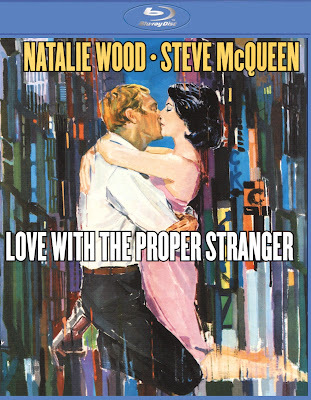
In 1963, the same year thatSteve McQueen became America’s favorite action hero via his role in TheGreat Escape, he also starred in a modest romantic drama opposite NatalieWood. Its name was Love with The Proper Stranger. It was a black-&-white indie (though released through Paramount Pictures), shot on and aroundthe streets of New York, by director Robert Mulligan and his longtime producingpartner, Alan J. Pakula. The two men, both early television veterans,specialized in small, tough, relatively low-budget films that appealed toaudiences tired of Hollywood glitz and glamour. The duo triumphed in 1962 withtheir film adaptation of To Kill a Mockingbird, which was to win threeOscars, including a Best Actor statuette for Gregory Peck. Today it seemsobvious that a strong film based on Harper Lee’s classic novel would reapgenerous rewards at the box office. But such was not the thinking in the earlySixties, when studio films played to audiences looking for romance and fancyclothes.
One year after To Kill aMockingbird, Pakula and Mulligan were back with a film that was in fact aromance, though hardly a conventional one. Steve McQueen plays an out-of-workjazz musician, first seen trolling for gigs at the local union hall. There he’sconfronted by Natalie Wood, a pretty young clerk at Macy’s. He has norecollection of going out on the town with her, but apparently he’s left hersomething to remember him by. Yes, she’s pregnant. Though she’s hardly theweepy type, he’s by no means a heel eager to escape responsibility. Calling infavors from his live-in girlfriend (Edie Adams), he locates an abortionistwho’ll take care of matters in an empty apartment for a substantial fee. (It’sa plot detail that’s starting to feel all too modern, now that Roe v. Wade ishistory.)
In a film that makes much ofethnic identity, both Wood’s and McQueen’s characters are the products ofclose-knit Italian families (Yup, we’re supposed to buy McQueen’s Rocky asItalian.) Wood’s character, Angie Rossini, lives at home with a domineeringbrother (Herschel Bernardi), as well as an old-world mama who wants her to stayon the straight and narrow. When she can’t bring herself to go through with theback-alley abortion arranged by McQueen, she tries dating a klutzy middle-agedgent who adores her and is willing to claim the baby as his own. (He’s playedby none other than Tom Bosley in his first film role, long before he became thebeloved paterfamilias on TV’s Happy Days.) Alas, the match doesn’t take.
Meanwhile, Angie’sindomitable spunk is starting to endear her to McQueen. (Given the strongethnic vibe in this film, it’s easy to see her as a close cousin to Cher’sOscar-winning Loretta Castorini from 1987’s Moonstruck.) I suspect youcan guess what happens at the end, though in the case of these two firebrandlovers, nothing is going to come easy.
Mulligan and Pakula must haveliked working with both McQueen and Wood. In 1965, the two actors starred inseparate Pakula-Mulligan projects. McQueen took the lead in another rawromance, Baby the Rain Must Fall, while Wood played the title role inthe downbeat story of a Hollywood star-in-the-making, Inside Daisy Clover. Thoughthey made a rather gorgeous couple, they never shared the screen again.Thegritty but ultimately hopeful Love with the Proper Stranger is wellworth seeing, both for its atmospheric look at ethnic New York and for thepairing of two stars on the rise. (It’s fun to imagine what a McQueen/Wood babymight look like!)
April 12, 2024
Taking a Leap with O.J. Simpson

I once saw Orenthal JamesSimpson at Los Angeles International Airport, walking at a steady clip,suitcase in hand. The moment stands out for me because, at the time that Ispotted him, the airwaves were filled with the famous Hertz commercials, inwhich O.J., clearly late for something important, dramatically hurtles overairport barricades to reach the car rental counter. That series of commercials (startingin 1975) struck a chord with the public because they captured what everyoneloved about O.J. in that era: the remarkable football skills, the charm, thehandsome face and resonant speaking voice.
As a UCLA student I hadplenty of opportunity to root against O.J. and his USC Trojans on the gridiron.Later, I was well aware that he’d successfully made the leap from running backto media superstar. Aside from his commercials, he did TV sports commentary,and honed his acting chops with memorable comic roles as a police detective inthree Naked Gun films (from the guys behind Airplane!). Like therest of America’s media watchers, I thought of Simpson as a big, strong guywith an endearing smile.
That all changed in 1994 whenSimpson was accused of murdering his ex-wife Nicole Brown and her friend RonGoldman. Like millions of others, I watched on TV part of the bafflinglow-speed White Ford Bronco chase, in which an apparently suicidal Simpsontried to avoid the L.A. cops sent to arrest him. From that point forward, itwas hard for a West L.A. person like me to ignore what was going on in O.J.’sworld. At the time, I was working for Roger Corman at Concorde-New HorizonsPictures, which had its grubby offices on San Vicente Boulevard in the L.A.suburb of Brentwood. A short walk away was the neighborhood Italian restaurantwhere Goldman had worked and where Nicole had enjoyed her last meal. It quicklybecame a media hot spot, but then went out of business. And my daily drive hometook me past the infamous condo where the two were stabbed to death. You canimagine how much the location’s notoriety added to the traffic on that stretchof Barrington Avenue.
Of course all the grimexcitement came to a head when the case went to trial—a “trial of the century”that would last a full year. In the course of it, many of the participantsbecame famous, including defense lawyerJohnnie Cochran, lead prosecutor Marcia Clark, and even judge Lance Ito (whofound himself subject to comic parodies, including “The Dancing Itos” on TheTonight Show with Jay Leno). Also on the defense team was RobertKardashian, now better known as the sire of a fabulously wealthy social media clan. What I remember best about the announcementof the verdict was my personal fear that L.A. might erupt in civil violence.Thankfully it didn’t happen, though in many people’s minds O.J. would never befully clear of the murder charges, despite his eventual acquittal.
Now Simpson himself has succumbed to cancer, but I suspect his fame will linger on. Once a media star, always a media star, right?
<
April 9, 2024
“Getting to Know You”: My UCLA Students and Me
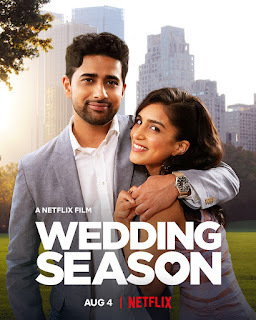
This week I begin, onceagain, teaching my advanced screenwriting rewrite course through UCLAExtension’s Writers’ Program. I invented this course a decade ago, putting touse the story skills I honed in my Roger Corman days. The course is taughtentirely online: I communicate with my 12 carefully selected students solelythrough the written word. Do you think, since we don’t meet in person, thatthey lose out on my up-close-and-personal attention? Think again!
Because this course, likemany offered through UCLA Extension, unfolds online, I interact with studentsfrom all over the world. Their work often reflects cultures far different frommy own, and introduces me to corners of the globe I would otherwise knownothing about. There’s something unique about encountering a sex scene—well, anear-sex scene—featuring a Catholic priest on a mission to Africa, as writtenby a Catholic priest currently back home in Dublin. I’ve had students fromChina, several from Australia, and a number from India. Some have been trainedfilmmakers who are looking to polish material they can eventually direct. Inone case, several years after a class was over, I enjoyed discovering what anIndian student’s script looked like when blown up on the big screen: it wasabout (yup!) an aspiring filmmaker from India who faces challenges galore whenhe comes to L.A. to attend film school. In no uncertain terms, lived experiencewas part of the script’s strength. Another Indian filmmaker, who had already wona prize for his short film at the prestigious Venice Film Festival, took myclass several times, struggling to expand his drama about Tibetan refugees inDharamshala into a full-length feature. I can’t wait to see what becomes ofthis powerful project.
As you can tell, I like tofollow my students’ progress, when I can. Of course, some students apply for mycourse mostly to challenge themselves, without serious hopes of starting a newcareer. A few are determined to put on screen some of the traumas they’ve facedin their own lives: this is a tricky business, because art requires a certaindistance from one’s personal woes. But using life as the source of art can alsomake it memorable. Next time I’m in Ojai, California, I plan to go to the locallibrary and take a gander at a certain mosaic armchair. The chair, made anddonated by a prominent local family, reflects a tragic mother-and-sons storytold, with great poignance, in the script of a student who lived it.
Happily, my students tend tobe interesting people doing remarkable things. Just days ago I checked in on aformer student, originally from Texas, who now makes his home in Taipei. Hisscripts (I’ve read several) lean on his longtime experience working at localradio stations. I’m also in touch with an Hungarian who, when not writingcharmingly eccentric screenplays, runs an eccentric café outside Budapest. Andthis past weekend I grooved to the sounds of a former student who, aside fromwinning a number of screenplay competitions, also performs around town as partof a very cool jazz and pop trio known as Guys & Doll.
Ah, but you’re probablywondering if any of my students have made the big time. Some, over the years,have worked hard and found their own niche in the film industry. I’ve got tomention with great pride Shiwani Srivastava, whose Wedding Season, was a Netflix hit in2022. When I first encountered this romantic comedy with its Southeast Asiantwist, I knew Shiwani had what it takes. And now – onward and upward!
Dedicated to DominiqueMerrill, who knows as well as I do that (asOscar Hammerstein once put it) when you become a teacher, by your pupilsyou’ll be taught.
Beverly in Movieland
- Beverly Gray's profile
- 10 followers



